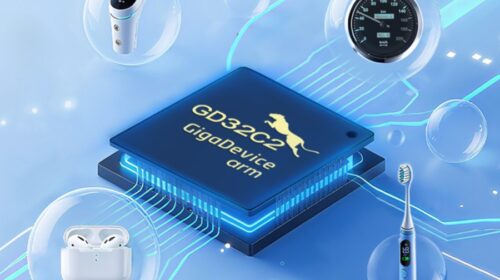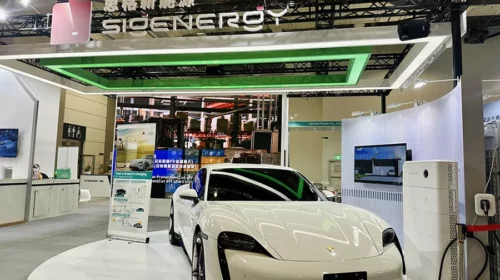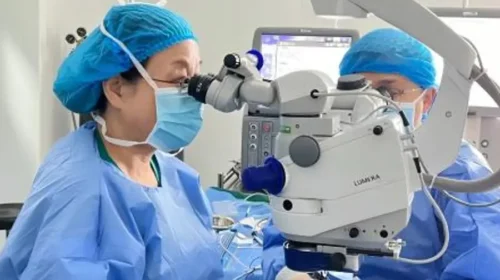NaaS zooms ahead with growing focus on EV infrastructure operators

China’s leading provider of electric vehicle charging services said its revenue rose more than 500% in the third quarter, and added the figure could grow as much as six-fold next year
Key Takeaways:
- EV services company NaaS said its revenue rose 536% in the second quarter, powered by a huge jump in its energy solutions business serving infrastructure operators
- The Bain Capital-backed company is rapidly expanding outside Mainland China, and expects to get 40% of its revenue from offshore sources next year
By Doug Young
Just over a year after its listing on the Nasdaq, China’s top electric vehicle (EV) charging services provider NaaS Technology Inc. (NAAS.US) is revving up with a major acceleration in its business.
The company reported its revenue accelerated more than 500% in the third quarter, as its energy solutions business, often involving infrastructure design and operations for business clients like charging stations, overtook its charging services business as a key revenue driver. But the even bigger surprise came as NaaS, which counts U.S. private equity giant Bain Capital as a major backer, unveiled a 2024 forecast that showed it expects its revenue to rise as much as six-fold next year.
The motor powering NaaS is a buzzing Chinese EV market that included 18 million new energy vehicles (NEVs) on the country’s roads as of September, according to a member of the Chinese Academy of Engineering speaking at an industry event. Those NEVs are serviced by China’s network of around 150,000 charging stations, with about half of those using NaaS’ services, according to the industry data from CIC.
NaaS’ home in China is the world’s largest NEV market, accounting for more than half of global sales. But as the rest of the world plays catchup, the company is aggressively expanding to other markets as well. The company’s services run the range from helping charging station operators to build and manage their facilities, to helping EV owners with their regular charging activities.
Leveraging its extensive data resources, NaaS strives to offer insights and assistance to clients within the EV ecosystem, enhancing their operational efficiency. In that process, NaaS has quickly discovered a huge demand for its services among the EV ecosystem’s many businesses, including charging station operators and providers of related services.
Unlike most other companies in the NEV realm, such as EV giant Tesla (TSLA.O) and charging station operator Charge Point (CHPT.US), NaaS is also distinguished by its business model as an “asset light” services company, which means it can expand rapidly at relatively low costs.
“We have fortified our local footprint by extending our partnership networks and winning new, important contracts in energy storage,” said CEO Wang Yang, who also uses the English name Cathy. “Meanwhile, our expansion beyond Mainland China has already yielded fruitful results and contributed 32.7% of total revenues this quarter.”
NaaS began trading on the Nasdaq in June last year, following a reverse merger with an existing listed company which also counted Bain Capital as a major shareholder. The stock rose 1.5% the day the results were announced last week, giving it a market value of about $800 million.
The company currently trades at a price-to-sales (P/S) ratio of 11, but the figure drops sharply to 2.4 using the midpoint of the company’s sales forecast for 2024. By comparison, Tesla trades at an inflated P/S ratio of 8, while Charge Point and Blink Charging (BLNK.US) trade at far lower ratios of 1.6 and 1.4, respectively.
NaaS clearly has yet to be discovered by most of the investment community due to its newness, which may partly explain its lackluster post-listing share performance. But it does appear to be gaining traction, including participation on its earnings call by analysts from big names like UBS, Jefferies and CICC, one of China’s leading homegrown investment banks.
Shifting focus
NaaS’ shifting focus from charging services to energy solutions, which broadly includes a greater focus on infrastructure operators, shows up quite noticeably in its revenue mix for the third quarter. The more mature charging services revenue, which provides charging station operators and EV owners with online and offline charging services, grew by a modest 23% year-on-year to 31.5 million yuan ($4.3 million) in the third quarter. By comparison, its more enterprise-focused energy solutions business, which provides integrated digital energy management solutions to fleet operators and companies, roared to 138.8 million yuan in revenue from just 300,000 yuan a year earlier.
Those two elements were the main engines behind NaaS’ 536% overall year-on-year revenue growth, which rose to 171 million yuan in the third quarter. The company also reiterated its earlier guidance for revenue 500 million yuan to 600 million yuan for the full year.
Even more impressive, the company disclosed it expects to generate between 2 billion yuan and 3 billion yuan in revenue next year, which would represent anywhere from a three-fold to as much as a six-fold gain from 2023.
One of the biggest growth areas for NaaS is helping charging station operators build energy storage facilities. CFO Alex Wu said NaaS has built 43 such stations this year, out of contracts for 380 in total it expects to build by year-end. But the big boom will come next year, when the company expects to deliver another 1,500 such storage stations, he added on the earnings call.
“We are beginning to recognize advantages from economies of scale, enabling us to gain significant operating leverage,” Wu said.
As its scale and experience grow, NaaS significantly improved its gross profit margin to 27.4% in the third quarter from just 6.1% a year earlier. The company’s non-IFRS loss was 176 million yuan, with net margin improving from negative 359% to negative 103%. The company had about 400 million yuan in cash at the end of September, which includes $70 million it raised from its sale of convertible notes to investor LMR Partners in July and September.
We’ll close with a look at NaaS’ drive to internationalize, which would further expand its footprint outside China as the nation’s EV sector slows more quickly than previously expected. According to the latest data from the China Association of Automotive Manufacturers, the sector still grew 37.5% in the third quarter year-on-year, slowing from earlier in the year.
NaaS logged just under a third of its revenue from outside Mainland China in the third quarter, up from 22% in the second quarter, and Wu said he expects the figure to rise to 40% next year. Much of that looks related to a recent Hong Kong acquisition, Sinopower Hong Kong, which allows NaaS to tap into the potential of solar energy and charging services in Hong Kong.
“For overseas expansion, what we’re doing currently is really a replication of what was done with Hong Kong Sinopower, which is to choose the right asset to buy it at the right price and also most importantly, to integrate it with our overall business and provide synergy and capabilities as much as we can,” Wu said.
Have a great investment idea but don’t know how to spread the word? We can help! Contact us for more details.
The Bamboo Works offers a wide-ranging mix of coverage on U.S.- and Hong Kong-listed Chinese companies, including some sponsored content. For additional queries, including questions on individual articles, please contact us by clicking here.
To subscribe to Bamboo Works free weekly newsletter, click here






